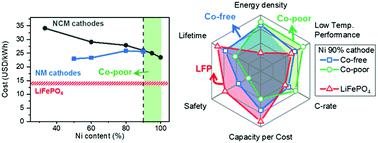当前位置:
X-MOL 学术
›
Energy Environ. Sci.
›
论文详情
Our official English website, www.x-mol.net, welcomes your
feedback! (Note: you will need to create a separate account there.)
Reducing cobalt from lithium-ion batteries for the electric vehicle era
Energy & Environmental Science ( IF 32.4 ) Pub Date : 2021-1-13 , DOI: 10.1039/d0ee03581e Hoon-Hee Ryu 1, 2, 3, 4 , H. Hohyun Sun 5, 6, 7, 8 , Seung-Taek Myung 4, 9, 10, 11 , Chong S. Yoon 2, 3, 4, 12 , Yang-Kook Sun 1, 2, 3, 4
Energy & Environmental Science ( IF 32.4 ) Pub Date : 2021-1-13 , DOI: 10.1039/d0ee03581e Hoon-Hee Ryu 1, 2, 3, 4 , H. Hohyun Sun 5, 6, 7, 8 , Seung-Taek Myung 4, 9, 10, 11 , Chong S. Yoon 2, 3, 4, 12 , Yang-Kook Sun 1, 2, 3, 4
Affiliation

|
The steady increase in global sales of electric vehicles (EVs) owes much to high-energy-density lithium-ion batteries, whose energy density and cost are largely dictated by the cathodes. Although Ni-rich, layer-structured cathodes have been adequate for application in the existing fleet of EVs, there are compelling reasons to eliminate Co from the current family of layered oxide cathodes. However, the realization of Co-free cathodes poses significant technical challenges. In this perspective, we compare the performances and cost efficiencies of Co-free Li[NixMn1−x]O2 (NM), Co-poor Li[NixCoyMn1−x−y]O2 (NCM), with x > 0.9, and LiFePO4 (LFP) cathodes, to evaluate their commercial viability for future EVs. We then systematically outline the intrinsic challenges and possible strategies for the development of advanced Co-free/Co-poor layered and LFP cathodes. As battery requirements vary depending on their application, a range of distinct Co-free/Co-poor cathodes will be required to address diverse commercial needs.
中文翻译:

减少电动汽车时代锂离子电池中的钴
电动汽车(EV)全球销量的稳定增长在很大程度上归功于高能量密度的锂离子电池,其能量密度和成本在很大程度上取决于阴极。尽管富镍,层状结构的阴极已经足够在现有电动汽车中使用,但仍有令人信服的理由将其从当前的分层氧化物阴极系列中消除。然而,无钴阴极的实现带来了重大的技术挑战。从这个角度,我们比较了无钴Li [Ni x Mn 1- x ] O 2(NM),贫钴Li [Ni x Co y Mn 1- x - y ] O 2的性能和成本效率。(NCM)(x > 0.9)和LiFePO 4(LFP)阴极,以评估其在未来电动汽车上的商业可行性。然后,我们系统地概述了开发高级无钴/贫钴分层和LFP阴极的内在挑战和可能的策略。由于电池要求因其应用而异,因此将需要一系列独特的无钴/贫钴阴极,以满足各种商业需求。
更新日期:2021-01-13
中文翻译:

减少电动汽车时代锂离子电池中的钴
电动汽车(EV)全球销量的稳定增长在很大程度上归功于高能量密度的锂离子电池,其能量密度和成本在很大程度上取决于阴极。尽管富镍,层状结构的阴极已经足够在现有电动汽车中使用,但仍有令人信服的理由将其从当前的分层氧化物阴极系列中消除。然而,无钴阴极的实现带来了重大的技术挑战。从这个角度,我们比较了无钴Li [Ni x Mn 1- x ] O 2(NM),贫钴Li [Ni x Co y Mn 1- x - y ] O 2的性能和成本效率。(NCM)(x > 0.9)和LiFePO 4(LFP)阴极,以评估其在未来电动汽车上的商业可行性。然后,我们系统地概述了开发高级无钴/贫钴分层和LFP阴极的内在挑战和可能的策略。由于电池要求因其应用而异,因此将需要一系列独特的无钴/贫钴阴极,以满足各种商业需求。











































 京公网安备 11010802027423号
京公网安备 11010802027423号